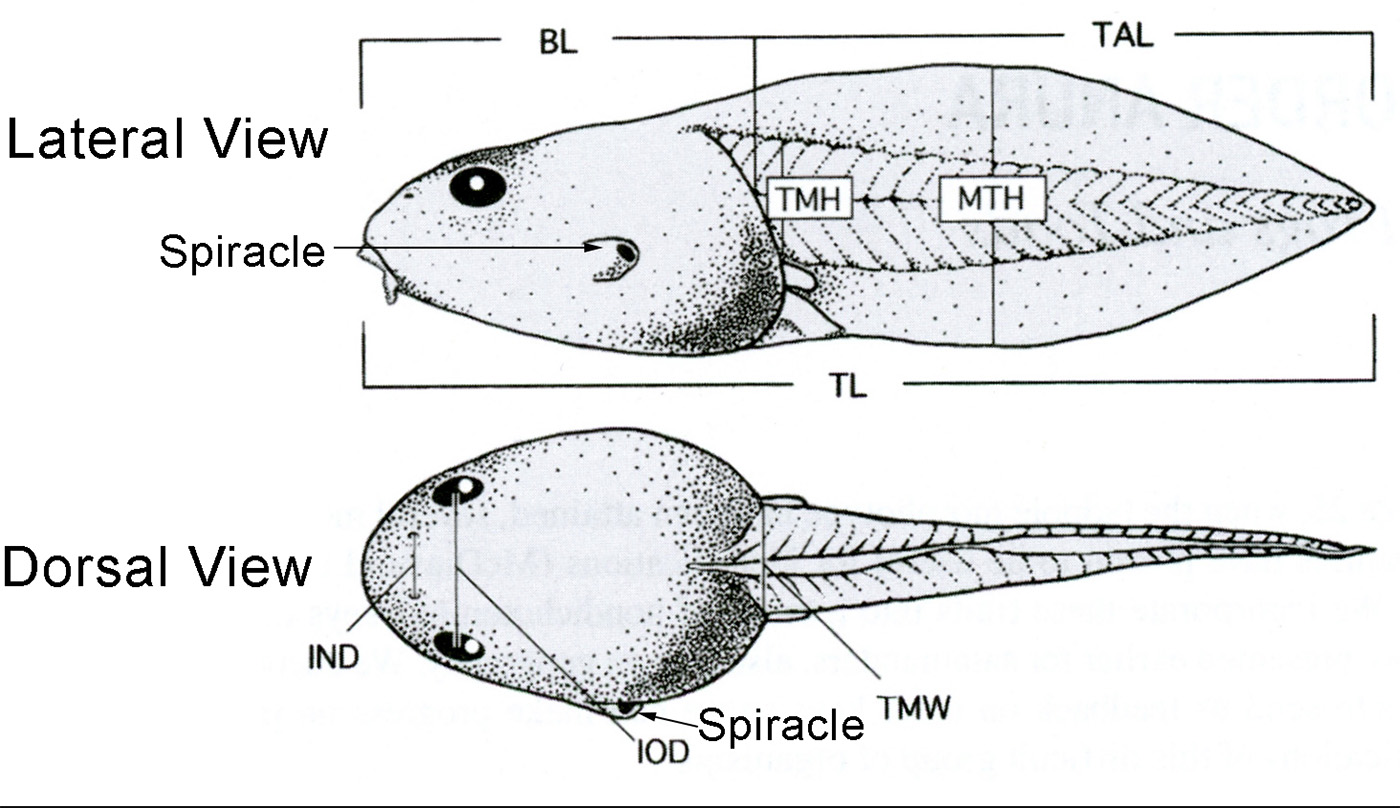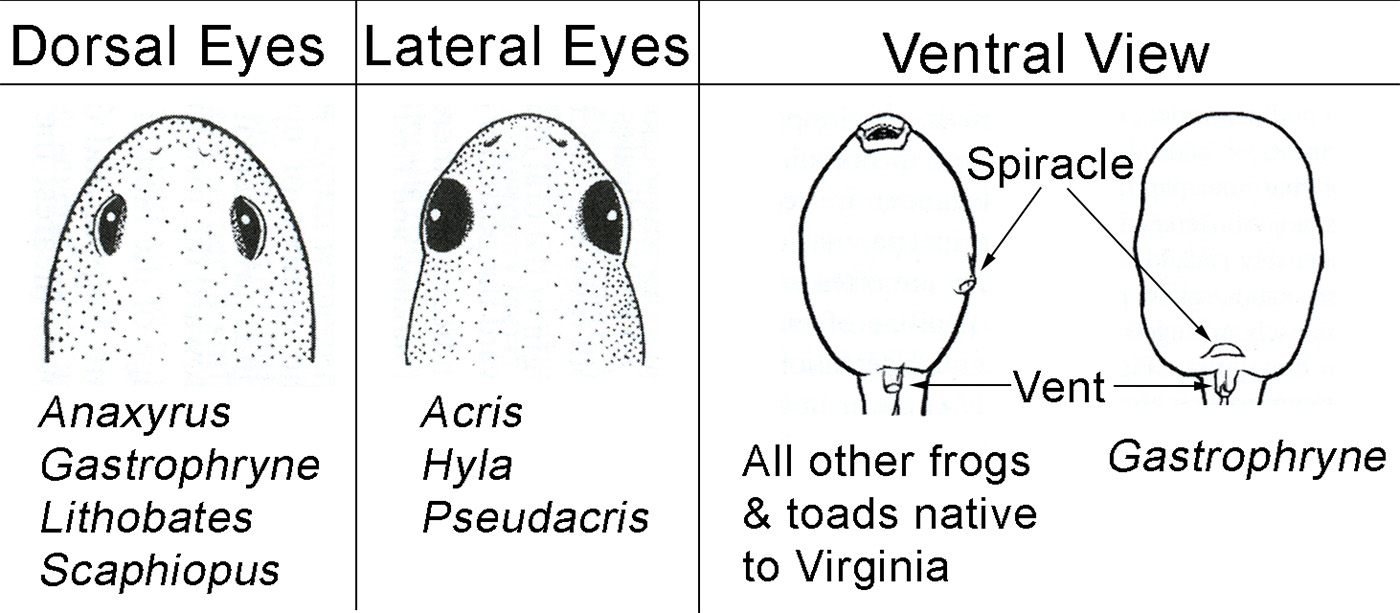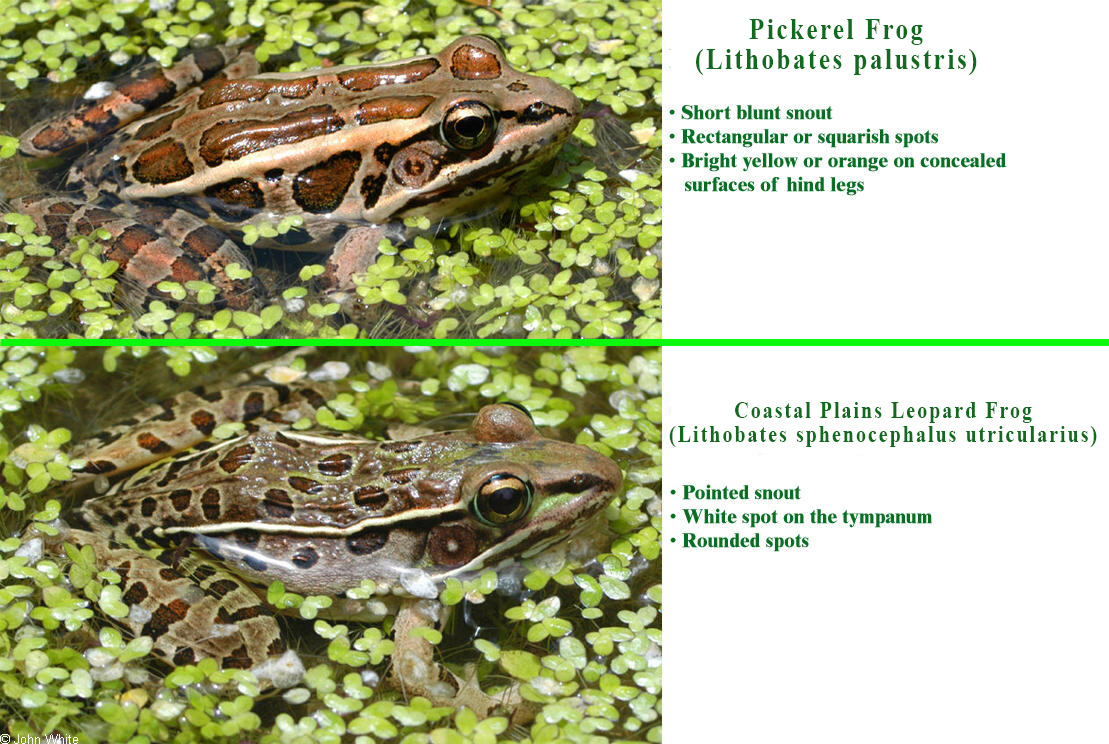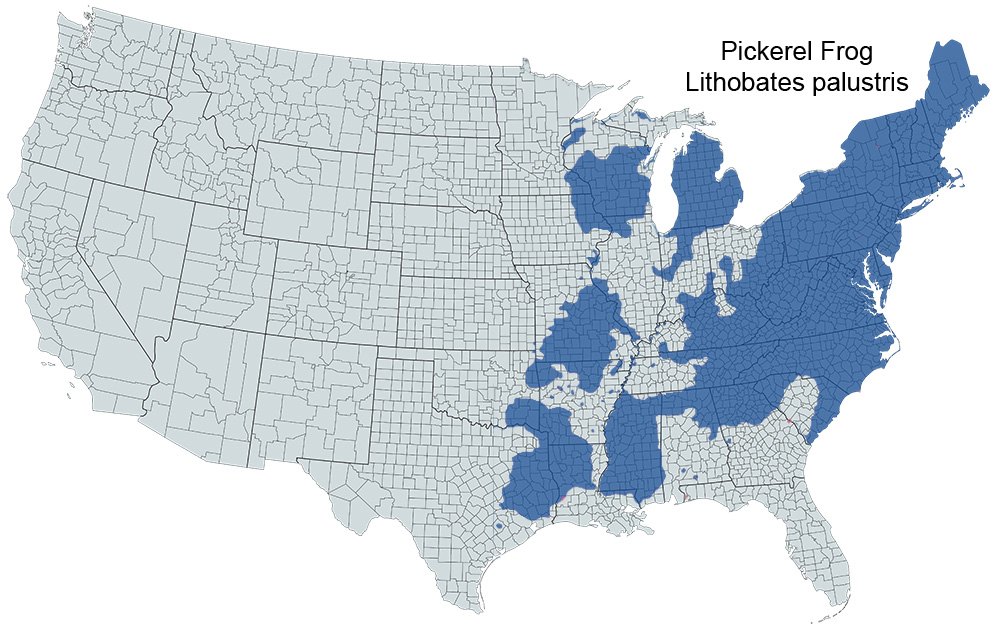Pickerel Frog
Lithobates palustris
Common Name: |
Pickerel Frog |
Scientific Name: |
Lithobates palustris |
Etymology: |
|
Genus: |
Lithobates is Greek, Litho means "A stone", bates means "One that walks or haunts" |
Species: |
palustris is Latin meaning "of the marsh" |
Average Length: |
1.8 - 3 in. (5.7 - 10 cm) |
Virginia Record Length: |
|
Record length: |
4.5 in. (11.4 cm) |
Physical Description - This is a medium-sized to moderately large frog, typically reaching lengths of 44-87 mm (1.75-3.5 in). It has two parallel rows of squarish spots on its back. There are dorsolateral folds extending towards the groin area. Concealed surfaces of hind legs and groin are bright yellow to orange. There is a light line along the upper jaw. The ventrum is white and may be mottled. Young individuals will have a metallic luster but no bright colors on leg surfaces and the lower lip will be shaded with dark pigment. Glandular secretions from the skin make this species unlikely prey of snakes.
Historical versus Current Distribution - Pickerel Frogs (Lithobates palustris) are distributed from Nova Scotia and New Brunswick, west through southern Québec and Ontario, to Michigan, Wisconsin, and extreme southeastern Minnesota. From southeast Minnesota south along the Mississippi Drainage (west to extreme southeast Kansas and eastern Oklahoma, but absent from interior prairies of Illinois) to the Gulf Coast in eastern Texas. Absent from most of the eastern Gulf Coastal Plain (except Conecuh County, Alabama, and Escambia County, Florida). In the eastern United States, they are generally distributed from New England south to South Carolina and Georgia, where they are apparently absent from the Atlantic Coastal Plain (Smith, 1961; Schaaf and Smith, 1971; Pace, 1974; Mount, 1975; Ashton and Ashton, 1988; Conant and Collins, 1991).
The similarity to northern leopard Frogs (L. pipiens, Schaaf and Smith, 1970; Pace, 1974; Hunter et al., 1992; Redmer and Mierzwa, 1994) has lead to erroneous records. Around the peripheries of their range, Pickerel Frog populations may be localized in suitable habitat, and special efforts may be needed to detect new localities or to relocate them at or near historical localities (Redmer, 1998b). For example, during surveys in Illinois, Pickerel Frogs were found in 10 (~59%) of 17 counties with previous historical records, but five new county records also were reported (Walley, 1991; Redmer and Mierzwa, 1994; Redmer and Ballard, 1995; Redmer et al., 1995; Redmer, 1998b; Petzing et al., 1998). They may be extirpated in the urban Chicago region and at a locality in extreme southern Illinois (Mierzwa, 1998a; Redmer, 1998b). Vogt (1981) reported only 15 active localities in Wisconsin, but Johnson (1984) identified 61 active localities (a 407% increase) in the state.
Historical versus Current Abundance - Unknown. It is unclear whether Pickerel Frogs have suffered range-wide decline, though their somewhat specialized habitat characteristics and intolerance of pollution may make them vulnerable to human activities (Redmer and Mierzwa, 1994; Harding, 1997). Because Pickerel Frogs are sometimes difficult to detect (Mossman et al., 1998; Redmer, 1998b), periodic species-specific surveys may be needed to monitor populations.
Breeding migrations - Timing and length of breeding season follow a south–north cline. The reported breeding season ranges from December–May in the south (Mount, 1975; Garrett and Barker, 1987; Dundee and Rossman, 1989; Trauth et al., 1990; Hardy and Raymond, 1991), March–May in the middle of their range (Walker, 1946; Minton, 1972; Vogt, 1981; Johnson, 1984; Green and Pauley, 1987; Johnson, 1987; Shaffer, 1991; Redmer and Mierzwa, 1994; Redmer, 1998b), and May–June in the north (Hunter et al., 1992; Oldfield and Moriarty, 1994).
Immigration takes place after one or a combination of the following occurs: water temperatures reach 7–18 ˚C (Wright, 1914; Moore, 1939; Pope, 1944; Johnson, 1984; Hardy and Raymond, 1991), air reaches 10–26 ˚C (Wright, 1914; Pope, 1944; Johnson, 1984), or surface soil temperature reaches 7–12 ˚C (Hardy and Raymond, 1991). Weather conditions greatly affect emergence from caves where frogs winter (Resetarits, 1986). In southwestern Illinois, males and gravid females are found on roads as they move towards breeding ponds during late March and April (unpublished data).
Breeding habitat - Breed in a variety of aquatic habitats adjacent to adult habitat, including woodland pools and ponds, stream overflow pools, farm ponds, sinkhole ponds, floodplain wetlands, marshes, and flooded quarries (Smith, 1961; DeGraaf and Rudis, 1983; Johnson, 1984; Resetarits, 1986; Adams and Lacki, 1993; Redmer and Mierzwa, 1994; Harding, 1997; Redmer, 1998b). Brown (D.R., 1984) reported oviposition in a cave pool in Indiana.
Egg deposition sites - Oviposition takes place more often in eutrophic zones than oligotrophic ones, but dissolved oxygen was high and water temperature was cool at breeding sites in Wisconsin (Johnson, 1984). Eggs are attached to dead or submerged vegetation at or near the water surface and are often concentrated in portions of the pool that receive greatest sunlight (Johnson, 1984; Harding, 1997; unpublished data).
Clutch size - Unknown. Egg masses are spherical; while the inner most embryos develop in a more hypoxic environment than those in the outer egg mass, ciliated epithelia of the embryos are used to create convective ventilation (Burggren, 1985). Under natural conditions, larvae hatch within 10–24 d (Johnson, 1984; Harding, 1997). In the lab, eggs hatch in 6–8 d (unpublished data).
Larvae/Metamorphosis - Under natural conditions, larvae begin to metamorphose within 60–90 d after hatching (Johnson, 1984; Harding, 1997). In the lab, metamorphosis occurs from 75–90 d following hatching (unpublished data).
Tadpoles:

| Lateral View | Dorsal View |
|---|---|
| BL = Body Length | IND = Internarial Distance |
| MTH = Maximum Tail Height | IOD = Interorbital Distance |
| TAL = Tail Length | TMW = Tail Muscle Width |
| TL = Total Length | |
| TMH = Tail Muscle Height |

Juvenile Habitat - Specific data are not available, presumably similar to that of adults.
Adult Habitat - Often reported to prefer streams or ponds with cool, unpolluted water (Dickerson, 1906; Toner and St. Remy, 1941; DeGraaf and Rudis, 1983; Cook, 1984; Conant and Collins, 1991; Harding, 1997), but Johnson (1984) found no evidence to support this. Stream corridors may be important conduits for movements in forests (Gibbs, 1998a). Some coastal and floodplain populations are reported to occupy swamps (Smith, 1961; Hardy, 1964; Schaaf and Smith, 1970). The most cave-adapted North American anuran, they are often abundant in areas of karst topography (Smith, 1961; Schaaf and Smith, 1970; McDaniel and Gardner, 1977; Resetarits, 1986). Individuals occurred in a Missouri cave from July–March (Resetarits, 1986). They may also enter abandoned mines (Heath et al., 1986). Other habitats include wooded wetlands, bogs, and shrubby, open meadows (Dickerson, 1906; DeGraaf and Rudis, 1983; Johnson, 1984; Redmer and Mierzwa, 1994; Harding, 1997). They prefer the margins of aquatic habitats with dense herbaceous vegetation (Pope, 1944; DeGraaf and Rudis, 1983; Johnson, 1984; Redmer and Mierzwa, 1994). Rural land use proximal to occupied habitats may or may not influence occurrence, though adults may be less abundant where stream bank vegetation is mowed or grazed (Johnson, 1984) or absent from areas that are logged (Cook, 1984).
Home Range Size - Unknown
Territories - Unknown.
Aestivation/Avoiding Dessication - True aestivation is unknown. Warm summer temperatures may cause individuals to become nocturnal (Harding, 1997). In Missouri, some individuals retreat to caves during summer (Resetarits, 1986). Critical thermal maxima and capacity for acclimation to changing thermal conditions have been reported (Moore, 1939; Brattstrom and Lawrence, 1962; Brattstrom, 1968).
Seasonal Migrations - Pickerel Frogs migrate from breeding areas (pools or ponds) to summer habitat (stream sides) where individuals may remain sedentary during spring and summer until they return to hibernacula in the fall (Johnson, 1984).
Torpor (Hibernation) - Overwinter in the mud bottoms of ponds (DeGraaf and Rudis, 1983; Green and Pauley, 1987; Harding, 1997), ravines (Wright, 1914; DeGraaf and Rudis, 1983), under mud, rock, or debris in spring seeps and pools (Johnson, 1984), and in or around the edges of pools in caves (Resetarits, 1986). In spring-fed habitats, individuals may remain active (Pope, 1944; Harding, 1997).
Interspecific Associations/Exclusions - Often reported to exclude Northern Leopard Frogs (Manion and Cory, 1952; Johnson, 1984; Conant and Collins, 1991), but the reasons are unknown. It is believed that skin toxins (see "Anti-predator Mechanisms" below) may kill other anurans kept in the same collecting container (Behler and King, 1998). Because of their anti-predator effect, it has been suggested that toxic skin secretions may be an adaptive advantage that makes Pickerel Frogs more abundant than Northern Leopard Frogs where they are sympatric (Dunn, 1935). Experimental evidence indicates that larvae compete with those of American Toads (Anaxyrus americanus; Wilbur and Fauth, 1990), but this is not affected by reproductive phenology (Alford, 1989b).
Age/Size at Reproductive Maturity - Age at reproductive maturity is unknown. Size at maturity is sexually dimorphic, with females averaging larger than males (Walker, 1946; Smith, 1961; Johnson, 1984; Resetarits and Aldridge, 1988; Hardy and Raymond, 1991). Minton (2001) reports a size range of 43.0 to 56.5 mm (mean 52.0) for adult males and from 54 to 78 mm (mean 64.0) for adult females.
Longevity - Unknown.
Feeding Behavior - Detailed studies of diet are unknown. Adults are reported to feed on insects, spiders, and other invertebrates (Pope, 1944; Harding, 1997). Tadpoles feed on algae and detritus (Pope, 1944; Harding, 1997).
Predators - Few observations of natural predation have been reported. Applegate (1990) reported predation by bald eagles (Haliaeetus leucocephalus), and Beane (1990) reported two frogs from the stomach of a mink (Mustela vison). Captive Bullfrogs (Lithobates catesbeianus) and Green Frogs (L. clamitans) will eat small adults (Pope, 1944). A number of other vertebrate species (such as snakes, birds, and raccoons) may prey on adults. Some observations and experiments suggest that this species is distasteful to some predators (see "Anti-predator Mechanisms" below). Humans use adults as fishing bait (Cook, 1984). Several fish species were listed as potential tadpole predators in a stream (Holomuzki, 1995). Predators in experimental studies of larvae included newts (Notophthalmus viridescens), dragonfly naiads (Anax sp.), and diving beetles (Dytiscus verticalis; Brodie and Formanowicz, 1983; Wilbur and Fauth, 1990). Various other aquatic predators may prey on tadpoles.
Anti-Predator Mechanisms - Adults may have skin secretions that are toxic or distasteful to predators (Dickerson, 1906; Schaaf and Smith, 1970), and the bright yellow-orange colors on the concealed surface of the hind legs may serve to warn predators (Wright and Wright, 1949). Published observations and experimental evidence both support (Wright, 1932; Pope, 1944; Wright and Wright, 1949; Formanowicz and Brodie, 1979) and question (Mulcare, 1965) whether skin secretions are toxic or distasteful to predators. A combination of defensive posture and distasteful skin secretions may make this species unpalatable to shrews (Formanowicz and Brodie, 1979). Defensive behaviors and postures may be used in response to snakes (Marchisin and Anderson, 1978). In streams, choice of oviposition sites may make tadpoles unavailable to predatory fishes (Holomuzki, 1995). Unpalatability, rapid growth/size, or behavior (reduced activity or use of fish inaccessible areas) have been suggested as anti-predator mechanisms of tadpoles (Formanowicz and Brodie, 1982; Brodie and Formanowicz, 1983; Holomuzki, 1995).
Diseases - Little is known about natural disease and non predation-caused mortality. A "red-leg" bacterial infection was reported in a cave (Lee and Franz, 1973). Johnson (1984) speculated that disease may have caused declines in Wisconsin during the 1970s. Devillars and Exbryant (1992) listed this species as one affected by a residue of the toxic pesticide dichlorodiphenyl trichloroethane (DDT)
Parasites - Reported parasites include trematodes (Bosma, 1934; Kuntz, 1941; Rankin, 1945; Goodchild, 1948; Walton, 1949; Bouchard, 1951; Coggins and Sajdak, 1982; McAllister et al., 1995b), cestodes (McAllister et al., 1995b), nematodes (Walton, 1929; Harwood, 1930, 1932; Coggins and Sajdak, 1982; Rankin, 1945; Baker, 1978a; McAllister et al., 1995b), and mites (Loomis, 1956; Murphy, 1965; McAllister et al., 1995b). Parasitic and commensal protozoans have also been reported (Metcalf, 1923; Walton, 1963; McAllister et al., 1995b; McAllister and Trauth, 1996).
Conservation - Pickerel Frogs are listed as Declining in Iowa (Christiansen, 1981), as Declining and a Species of Special Concern in Wisconsin (Casper, 1998; Mossman et al., 1998) and (due to restricted range) a Species of Special Concern in Minnesota (Oldfield and Moriarty, 1994; Lannoo, 1998d). Pickerel Frogs may be extirpated in Kansas (Platt et al., 1974; Collins, 1993). Some authors report that they are common regionally (DeGraaf and Rudis, 1983; Green and Pauley, 1987; Johnson, 1987; Hunter et al., 1992), while others report that they are rare, uncommon, or localized (Minton, 1972; Pentecost and Vogt, 1976; Vogt, 1981; Christiansen and Bailey, 1991; Redmer and Mierzwa, 1994; Harding, 1997; Redmer, 1998b).
References for Life History
- Altig, Ronald & McDiarmid, Roy W. 2015. Handbook of Larval Amphibians of the United States and Canada. Cornell University Press, Ithaca, NY. 341 pages.
- AmphibiaWeb. 2020. University of California, Berkeley, CA, USA.
- Conant, Roger and, Collins, John T., 2016, Peterson Field Guide: Reptiles and Amphibians, Eastern and Central North America, 494 pgs., Houghton Mifflin Company., New York
- Duellman, William E. and, Trueb, Linda, 1986, Biology of Amphibians, 671 pgs., The Johns Hopkins University Press, Baltimore
- Martof, B.S., Palmer, W.M., Bailey, J.R., Harrison, III J.R., 1980, Amphibians and Reptiles of the Carolinas and Virginia, 264 pgs., UNC Press, Chapel Hill, NC
- Wilson, L.A., 1995, Land manager's guide to the amphibians and reptiles of the South, 360 pp. pgs., The Nature Conservancy, Southeastern Region, Chapel Hill, NC
Photos:
*Click on a thumbnail for a larger version.
Leopard Frogs vs. Pickerel Frog

Verified County/City Occurrence
Accomack
Albemarle
Alleghany
Amelia
Amherst
Appomattox
Augusta
Bath
Bedford
Bland
Botetourt
Brunswick
Buchanan
Buckingham
Campbell
Caroline
Carroll
Charles City
Charlotte
Chesterfield
Clarke
Craig
Culpeper
Cumberland
Dickenson
Dinwiddie
Fairfax
Fauquier
Floyd
Fluvanna
Franklin
Frederick
Giles
Gloucester
Goochland
Grayson
Greene
Greensville
Halifax
Hanover
Henrico
Henry
Highland
Isle of Wight
James City
King and Queen
King George
King William
Lancaster
Lee
Loudoun
Louisa
Lunenburg
Madison
Mathews
Mecklenburg
Montgomery
Nelson
New Kent
Nottoway
Orange
Page
Patrick
Pittsylvania
Powhatan
Prince Edward
Prince George
Prince William
Pulaski
Rappahannock
Richmond
Roanoke
Rockbridge
Rockingham
Russell
Scott
Shenandoah
Smyth
Southampton
Spotsylvania
Stafford
Surry
Sussex
Tazewell
Warren
Washington
Westmoreland
Wise
Wythe
York
CITIES
Alexandria
Charlottesville
Fairfax
Lynchburg
Newport News
Roanoke
Salem
Suffolk
Williamsburg
Winchester
Verified in 90 counties and 10 cities.
U.S. Range












